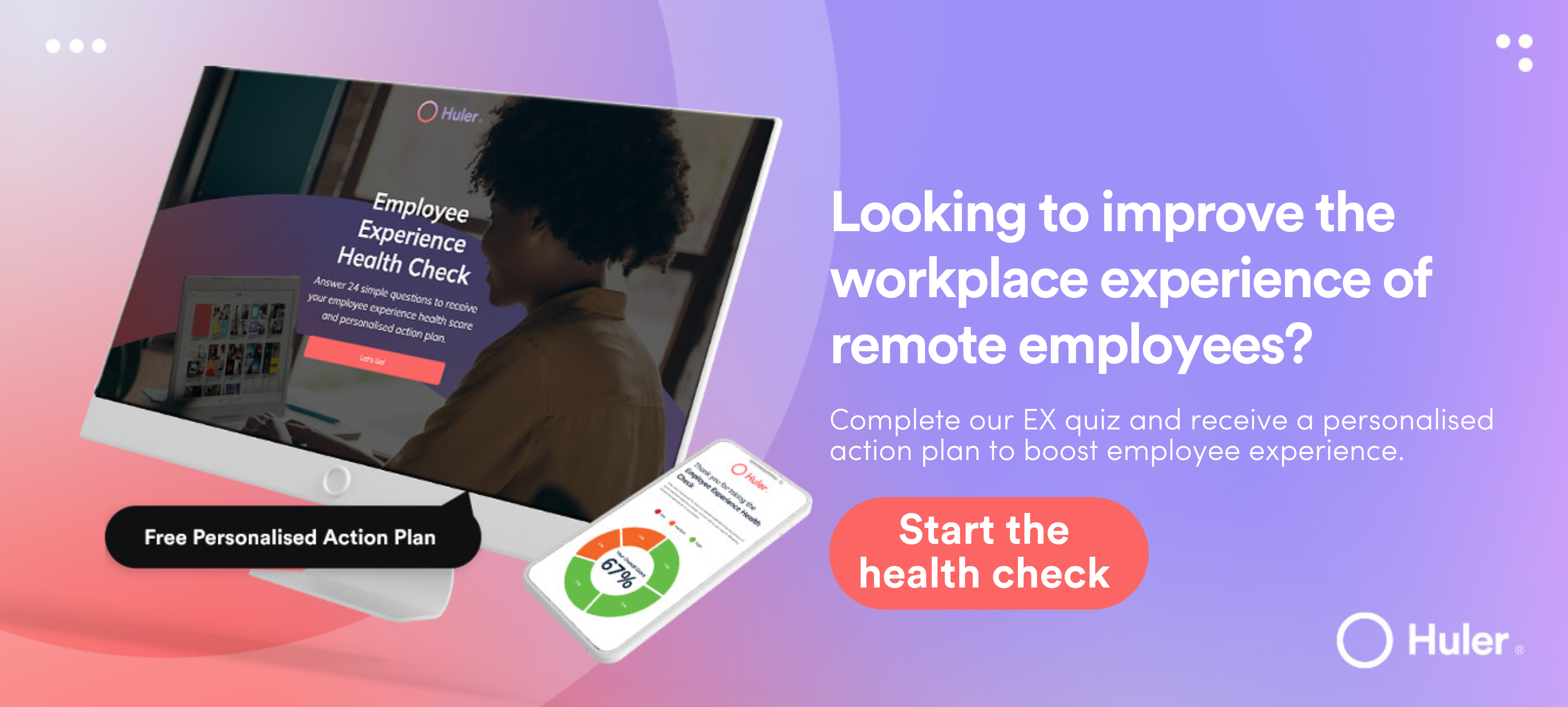The employee experience is shaped by many components. It encompasses everything that your employees see, feel, and interact with over the course of their employment and determines how they feel about work each day.
In May 2022, job vacancies across the UK outstripped the number of people seeking work for the first time. Considering the tightening labour market, improving employee retention should be a top priority for companies – starting with the employee experience. But how exactly do we pause and assess what truly matters to our employees when the experiences they have can feel very much out of our control?
In this article, we’ve done the legwork for you. Using our expertise and experience in HR, internal communications and digital transformation, we have distilled the employee experience down to 5 core elements to help you focus on making changes that move the needle and directly impact return on investment, retention, productivity and employee engagement.
5 Elements Of The Employee Experience (& How To Improve Them)
Preboarding/Onboarding
All employee experiences start with the recruitment and onboarding process. It is the first impression an individual gets of your organisation, from your core values down to salary and expectations of the role.
Taking a people-first approach to both the pre- and onboarding process builds the foundations for a positive employee experience. Here are our top tips for achieving that for your new hires:
- Transparency: No one likes hidden surprises. Or worse, to feel like their time’s been wasted. In recruitment processes, it’s important to be transparent about your organisation, the job, expectations, core duties, experience, compensation, and benefits. According to SHRM, when looking at a job posting, compensation and benefits are the primary thing that most candidates are looking for. So it’s best not to beat around the bush and instead be up front from the beginning with potential new hires.
- Communication: Striking the right balance when it comes to communication can feel like a challenge. Over communicate and people feel overwhelmed. Under communicate and people might feel undervalued and a little bit lost! An excellent tonic to this is being intentional about how and when you communicate. At the beginning of the journey with your organisation, individuals are in the process of feeling out something new, so it’s inevitable they will have questions and even apprehensions. Aim to answer or allay these before they have the chance to come up. To achieve this, it’s important to look at what is important to employees and aim to fold that information into conversations, literature (i.e. policies and procedures), training and any other areas where you might communicate with new or potential new hires.
- Personalisation: Everything’s better when it’s personalised. Onboarding is a chance to make new employees feel special and valued, while creating a sense of excitement around their first day. This can be achieved through an employee experience platform, which is used to create a personalised digital workplace for employees filled with everything they need to succeed in their first few weeks. But it can go beyond that too. A handwritten note, or personalised video, from their manager accompanied by a gift goes a long way in setting your people up for success.
Culture
Your workplace culture plays a big role in the employee experience. It is, after all, the thing they live and breathe every day. The tricky thing is that your culture can feel hard to pin down, especially in hybrid or remote-first workplaces.
Having said that, it’s not impossible to shape a great workplace culture within a distributed team. It just takes a creative approach that doesn’t attempt to shoehorn old working practices into new. Here are a few tips to get you started:
- Shared Core Values: Every organisation should have a set of core values to work by. But simply having them written down in one document that nobody ever sees is not enough. From beginning to end all businesses should live, breathe and frequently share their core values, providing them as a guiding light for employees. Core values can be tied into many aspects of work from employee recognition through to company updates. The more frequently they are raised and applied to the day to day running of the business, the more likely they are to become ingrained in your culture.
- Recognition And Praise: According to Gallup if companies doubled the the number of employees they recognised every week there would be a 24% improvement in work quality, 27% reduction in absenteeism, and 10% reduction in staff shrinkage. Creating a culture of recognition and praise can be achieved through encouraging peer-to-peer feedback, as well as encouraging managers to share more positive feedback both publicly and privately in order to increase motivation and performance.
- Flexibility: Long gone are the days when employees were just numbers – or cogs in a machine. And thank goodness for that! Perhaps one good thing to come out of the pandemic was the realisation that in giving employees more trust and flexibility they are happier, more productive, motivated and inclined to stay in their role. Flexibility looks very different across organisations and sectors, but it is important to find a way to offer it in a way that works for your people. This might be achieved through flexible working arrangements, hybrid work models, work from anywhere capability, or more flexibility outside of core working hours.
- Togetherness and Belonging: Employees want to feel like their contribution truly matters. On top of that, they want to feel a sense of community and belonging among their peers. This can be tricky to achieve if part or all of your workplace is distributed, but not impossible. Whole company away days can be a fantastic way to bring everyone together on a personal level, allowing them time to build relationships that are removed from work and get to know one another in an informal capacity. In the day to day, making time for colleagues to chat to one another, as they would in an office, as well as collaborate across teams is a great way of reducing the loneliness and isolation that is so often associated with working out of the office.
Internal Communication
Effective communication should be baked into the foundation of every business. After all, success depends on how well the team, from the top down, is able to pull in the same direction toward shared goals. Internal communication forms the track for this. It clearly communicates key updates, as well as reinforcing a sense of community and belonging.
Once again, effective internal communication can be trickier among a distributed workforce, particularly if they work asynchronously. Ineffective communication can leave employees feeling lost and at sea amongst huge amounts of information.
- Relevancy: Employees engage best with internal communications when they can understand the relevance to them and their work. To avoid overwhelm and confusion, take steps to segment your workforce into audiences and target them with the most relevant internal communications for them, instead of taking a scattergun approach.
- Frictionless Discovery: In a hyper-connected cloud-based world, we’ve got so much information at our fingertips, but sometimes locating the right information at the right time seems like an impossible task. By centralising this information in one easy to find and access place (such as HulerHub), you can ensure knowledge sharing is quick, easy and painless for your people, so they can focus on the task at hand.
- Two-Way Feedback: All too often internal communications are one-sided. Facilitating two-way conversations as part of your internal communications strategy is crucial for giving employees a platform and a voice. That being said, it’s not enough just to ask for feedback, tuck it away in a folder somewhere and ignore it. You have to encourage and welcome that feedback, action it and communicate that action back to your people to effectively demonstrate that you are listening and value their input.
Technology
There’s no way around it, technology makes the world go around. As of April 2022, there were 5 billion internet users worldwide, and cloud computing is expected to grow at a compound annual growth rate of 17.5% by 2025. Therefore, it’s not surprising that harnessing the power of technology is a top priority for businesses right now.
Technology is a key enabler for positive employee experiences, especially in a hybrid and work from anywhere world. But it also has the potential to be quite overwhelming, further blurring the lines between a person’s work and personal life, contributing to burnout.
- Less is more: With so much work tech to choose from, it’s easy to find yourself in a position where you’re overwhelmed by all the tools and systems in your digital workplace. With no consistent way of bringing everything together, it can be difficult to assess which technology is working and which is sitting unused on a virtual shelf. When you’re intentional with your technology investments, it means taking the time to consider the best software for the goal at hand, how it integrates or rubs up against other technology, and the people who are going to be using it. Being intentional about technology uptake can increase adoption rates, drive usage, increase productivity and make life easy for your people.
- Centralised access: It’s unlikely to ever find a piece of technology that has the ability to support every job function in your organisation. Rather than chase what is effectively the unicorn of work technology, it might be better to put your efforts into finding a solution that centralises access to all of your cloud-based tools and content. Often, the main complaint from employees isn’t that the technology itself doesn’t work, it’s that it doesn’t fit into their workflow. Bringing in a digital workplace solution that corrals all of these systems together and makes them easily accessible in just a few clicks ticks that box without having to compromise.
- Mobile Capability: Not everyone works in an office. Whether they’re on the front-line, on-site or working remotely, all of your employees deserve consistent, reliable access to the information and systems they use. Selecting a digital workplace that delivers on that by allowing your people to access what they need, when they need it, on any device is crucial to enabling agility and ironing out frustrations across your workforce.
Growth
The last, but by no means least, element of employee experience is growth and personal development. The majority of your employees want to be challenged and to progress in their roles. For that reason, learning and development is a key element of the employee experience. What’s more, regularly upskilling and reskilling your workforce as technology evolves will improve retention and make organisational growth more seamless and organic.
- Defining Success: Clear parameters for success give your employees a roadmap they can work from. Regularly updated job descriptions, KPIs and objectives formulated in conjunction with each individual will ensure that everyone remains on the same page and provide context for the ‘why’ behind day to day activities.
- Diverse Learning Content: Everyone learns and retains new information differently. Therefore, it’s important to provide a wide range of different learning content that’s readily available to employees to enable them to undertake self-directed learning and own their personal development.
Take Control Of The Employee Experience
At Huler, we’re passionate about making work less hard work for everyone. We achieve this through the creation of bespoke work technology and our flagship employee experience platform, HulerHub.
If you’re looking to take control of the employee experience and all the elements within it, start with our employee experience health check. The quiz takes just 3 minutes to complete, and upon completion you’ll receive a free personalised report crammed full of actionable insights to help you reshape the employee experience in a people-first way.






